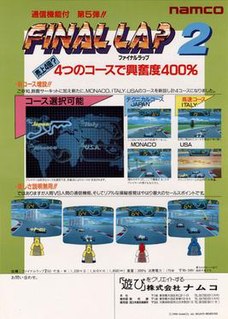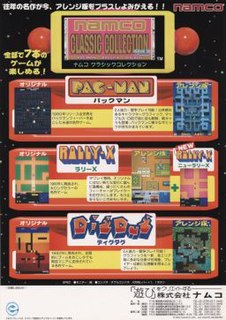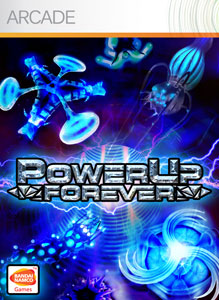 W
WActive Life: Extreme Challenge is a video game for the Wii platform, created by Bandai Namco Games. It is the sequel to the 2008 game Active Life: Outdoor Challenge and was released on August 11, 2009. The game uses a mat to play mini-games. The game-mat is different from the mat that is used in Dance Dance Revolution.
 W
WAttack of the Zolgear is an arcade game for one to six players released by Namco. It is a sequel to Galaxian 3. This game used two LaserDisc players simultaneously for the outer space background, while computer generated graphics were overlaid on top.
 W
WBlast Off is a vertical scrolling shooter arcade game that was released by Namco in 1989 only in Japan; it runs on Namco System 1 hardware, and despite the drastically different gameplay, it is the sequel to Bosconian which was released eight years earlier in Japan and the United States. In 2006, it was released for Japanese mobile phones through Namco Bandai Games' mobile game service.
 W
WBlazer is an isometric perspective scrolling shooter arcade game that was released by Namco in 1987, only in Japan; it runs on the company's System 1 hardware, and used a three-quarter-view perspective.
 W
WDirt Fox is a racing arcade game, which had been released by Namco in 1989 only in Japan; it runs on Namco System 2 hardware, and allows up to four players to play simultaneously, when four cabinets are linked together they can allow up to eight players to play simultaneously, when four two-player cabinets are linked together.
 W
WEmeraldia is a puzzle arcade game released by Namco in 1993 worldwide; it runs on the company's NA-1 hardware, and was the eighth game from them to allow scores not ending in "0" as well as the third of this type that did not use a Yamaha YM2151 for its music. On March 26, 2009, it was re-released on the Wii's Virtual Console - and the Stars also appear during the game's Normal mode, but this time they will eliminate every block of the colour that they land on. The Ojama Blocks in Versus mode also have the face of "Gerochan", the frog from Super World Court; they will appear upon the other player's side of the screen when one player eliminates a lot of blocks at once and cannot be eliminated.
 W
WFighter & Attacker is a 1992 vertical-scrolling shooter arcade game developed and published by Namco.
 W
WFinal Lap 2 is a sequel to Final Lap ; it runs on Namco System 2 hardware, and much like the original title, it allows up to eight players to play simultaneously when four two-player sit-down cabinets are connected together, but this one features four different tracks which are set in the game's home country of Japan, Italy, Monaco, and the United States. For a second time, the players must take control of either the Williams, McLaren, March or Lotus cars, which have been redesigned, in a Formula One race on one of the four tracks - and in the single-player mode, the player's score shall again be based upon how far his car travels until the timer runs out or he completes four laps of the chosen circuit, and hitting another car or a billboard will again not cause a player car to explode like it did in the two Pole Position games, but it can still send it spinning off the track, costing valuable time. In the multiplayer mode, up to eight players can again race simultaneously; this shall again allow for better lap times, as the plain green CPU-controlled cars shall appear less frequently. The United States track is the easiest of the four, and is recommended for the novice players - and once a player has mastered it, he is ready to move on to the Monaco track, then the Italy one. However, the Japan track is the most difficult one, given that it is the Suzuka Circuit from the original game and it is therefore only recommended for the expert players or the players who had managed to master it in the original.
 W
WFinal Lap 3 , as the name suggests, is the third title in the Final Lap series, released worldwide by Namco in 1992; like its precursors, it runs on Namco System 2 hardware, and allows up to eight players to play simultaneously when four two-player cabinets are linked together. It features four new tracks set in England, France, San Marino, and Spain - and for the third time, the players must take control of either the Williams, McLaren, Ferrari or Tyrrell cars, in a Formula One race on one of the four tracks. In the single-player mode, the player's score is again based on how far his car travels until the timer runs out or he completes four laps of the chosen circuit, and hitting another car or a billboard will again not cause a player car to explode, like it did in the two Pole Position games, but it can still send it spinning off the track, costing valuable time; in the multiplayer mode, up to eight players can again race simultaneously, which shall again allow for better lap times, as the plain green CPU-controlled cars will appear less frequently. Barcelona is the easiest one of the four and is recommended for the novice players - and once a player has mastered it he is ready to move on to Imola, followed by Paul Ricard. However, Silverstone is the most difficult one of the four and is therefore only recommended for the expert players and the ones who had managed to master Suzuka in the two previous titles.
 W
WFinal Lap R is a racing arcade game which was released by Namco in 1993; it was one of the only games to run on the company's System FL hardware, and is the fourth game in their Final Lap series. It was also licensed by FOCA to Fuji Television, and much like its predecessors, allows up to eight players to play simultaneously when four two-player cabinets are linked together - and it also features four new tracks set in Germany, Hungary, Belgium and Brazil. The colour of the CPU-controlled cars has also been changed from green to blue; however, there are also black ones.
 W
WFinest Hour is a 1989 run and gun arcade game developed and published in Japan by Namco. It was later re-released on the Wii Virtual Console on August 25, 2009.
 W
WFour Trax is a 1989 racing arcade game developed and published by Namco. It was released in North America by Atari Games, and was ported to the Sega Genesis in 1991 as Quad Challenge.
 W
WHello Kitty: Roller Rescue is a 2005 action-adventure-racing video game developed by XPEC Entertainment for the PlayStation 2, GameCube, Xbox, and Windows. The game features Hello Kitty and other Sanrio characters. The game also features additional character designs by Hunter Roberson and Rhett Deal.
 W
WJ-League Soccer V-Shoot , commonly referred to as just V-Shoot, is a soccer arcade game that was released by Namco in 1994 only in Japan; it runs on their NB-1 hardware, and features the twelve (then-current) teams from the J-League. All the players' names also reflect the teams' 1993 lineups - and a sequel, J-League Soccer Prime Goal EX, was released in 1996. Sega also released a J-League videogame of their own, The J-League '94.
 W
WMage Knight: Destiny's Soldier is a turn-based strategy video game for the Nintendo DS system based on the Wizkids Mage Knight tabletop game. It was produced by Namco and developed by Big Blue Bubble.
 W
WMappy Kids is a platform game sequel to the 1983 Namco/Midway arcade game Mappy. It was released for the Family Computer in Japan only.
 W
WMirai Ninja , is a side scrolling arcade game, released by Namco in 1988 exclusively in Japan. Mirai Ninja was adapted into the Japanese live-action film of the same name, which was also produced by Namco. The game runs on Namco System 2 hardware, and was the first Namco game which was adapted into a film.
 W
WMs. Pac-Man: Quest for the Golden Maze is a Microsoft Windows game published by Infogrames and released in 2001.
 W
WMuscle March is a video game by Namco Bandai Games for WiiWare. It was released in Japan on May 26, 2009, in North America on January 18, 2010 and the PAL region on March 19, 2010.
 W
WNamco Classic Collection Vol. 2 is a compilation arcade game that was released by Namco in 1996. It is a collection of three popular Namco games: Pac-Man (1980), Rally-X (1980) and Dig Dug (1982). In addition to the original games, there are "Arrangement" versions that include 2-player simultaneous play, additional enemies, updated graphics and music. Rally-X Arrangement did have 1-player only, unlike all other "Arrangements". In addition the game New Rally-X (1981) is selectable as well. It is a follow-up to Namco Classic Collection Vol. 1 (1995).
 W
WNavarone is a fixed shooter arcade game, that was released by Namco in 1980. It is the first of three monochromatic arcade games which were developed by the company during the early part of that year; the other two are Kaitei Takara Sagashi and SOS.
 W
WPowerUp Forever is a downloadable multi-directional shooter developed by Blitz Arcade and published by Namco Bandai for the Xbox 360 via Xbox Live Arcade and the PlayStation 3 via PlayStation Network. It was released on Xbox Live Arcade on December 10, 2008 and the PlayStation Network on December 11, 2008. The title is a reference to the game Warning Forever, which was one of the influences for the game
 W
WSokoban Deluxe is a puzzle arcade game released by Namco in 1990; it runs on Namco System 1 hardware, and is based on the Sokoban game series, by Thinking Rabbit. It is a graphically enhanced implementation of the then-8-year-old Japanese puzzle game phenomenon, and is the only implementation of Sokoban to be released in the arcades - and while it features all the rules of regular Sokoban it also has a timer which determines how long the player character, "Rabi-kun" will have to clear the current round, before the game ends - and even if the player decides that he or she has to start the round over, the timer will not be reset. If the player runs out of time, he or she can insert another coin to continue from the current round, with a full timer; there are fifty-five in all, and the player can start from the first, twelfth, twenty-third, thirty-fourth and forty-fifth ones. The five rounds whose numbers are multiples of eleven are also indicated with a question mark - and, after the player clears one of the five rounds whose numbers are multiples of ten, he or she shall actually get to see the following (question-marked) round. If the player clears a round in enough steps, he or she will also receive a "Best Steps" or "Good Steps" bonus - and some of the music in this game was later reused in Namco's unreleased prototype game Puzzle Club.
 W
WSteel Gunner 2 is an arcade game that was released by Namco in 1991; it runs on Namco System 2 hardware, and as the name suggests, it is the sequel to Steel Gunner, which had been released in the previous year. It was also sold as a conversion kit for Taito Corporation's Operation Thunderbolt (1988).
 W
WSuper World Court is a tennis arcade game which was released by Namco in 1992 worldwide; it runs on Namco NA-1 hardware, and as the name suggests, it is the sequel to Pro Tennis: World Court which was released four years earlier. At the start of the game, players must select either "singles" or "doubles" - they will then have to select one of sixteen new players and select one of the four new courts. The players must then decide whether they want their match to be one or three sets long; the company's signature character, Pac-Man, also makes a cameo appearance upon the Namco court. A timer counts down from a maximum of 360 seconds in the top-right corner of the screen; if it has run out by the time a set has been won, the players will have to insert another coin within ten seconds if they wish to continue playing, because if they do not, the losing player shall immediately forfeit the game.
 W
WTamagotchi Connection: Corner Shop is a shop simulator game released by Bandai in 2006 for the Nintendo DS and has characters from the Tamagotchi series. It was later followed by Tamagotchi Connection: Corner Shop 2, released late that same year. The game requires the player to choose one of three Tamagotchi to run a store, playing a different mini-game for each store to serve customers.
 W
WTenkaichi Bushi Keru Nagūru is a fighting video game developed by Game Studio and published by Namco. It was released for the Famicom on July 21, 1989 only in Japan. It is one of the earliest versus fighting games with role-playing video game elements.
 W
WPro Tennis: World Court is a tennis sports arcade game that was released by Namco in 1988 only in Japan; it runs upon Namco System 1 hardware, and was inspired by the 1987 Famicom game Family Tennis. In August 1988, the game was ported to the PC Engine console, in which a new tennis-based role-playing quest mode was added, and was later ported to the North American TurboGrafx-16 console by NEC under the title of World Court Tennis in 1989 - and a sequel named Super World Court was released in 1992, which ran on Namco NA-1 hardware and allowed up to four players to play simultaneously.